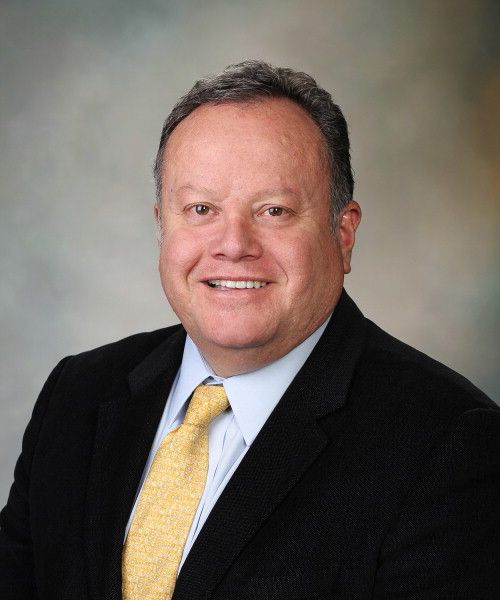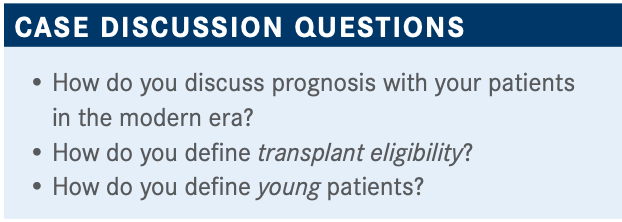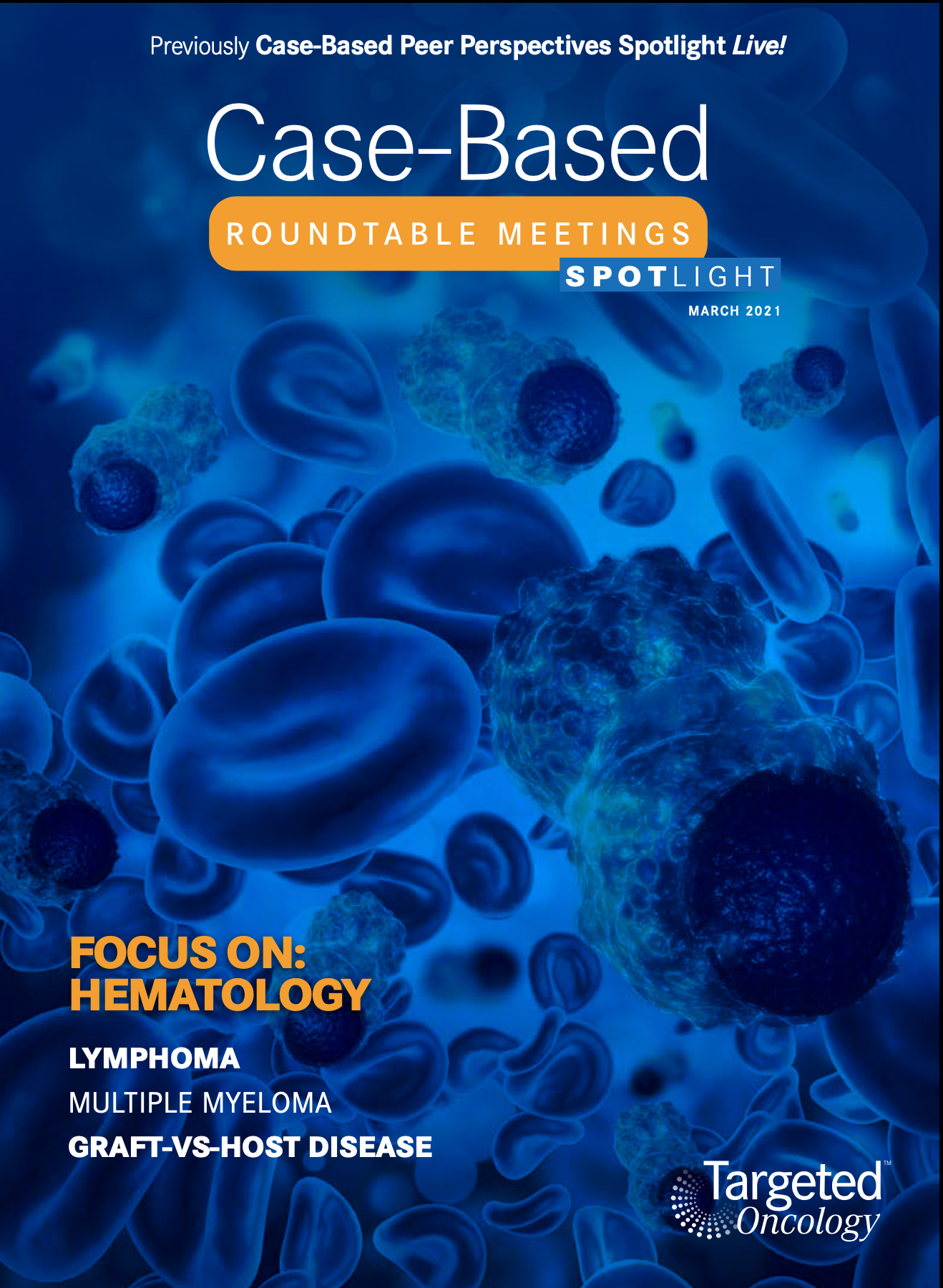Roundtable Discussion: Fonseca Leads Debate on the Use of Minimal Residual Disease in Multiple Myeloma
During a virtual Targeted Oncology Case-Based Roundtable event, Rafael Fonseca, MD, lead a discussion on how MRD status can guide treatment of multiple myeloma
Rafael Fonseca, MD

During a virtual Targeted Oncology Case-Based Roundtable event, Rafael Fonseca, MD, lead a discussion on how MRD status can guide treatment of multiple myeloma.

RAFAEL FONSECA, MD: How would you describe prognosis for patients with multiple myeloma?
QUILLAN HUANG, MD: That’s a tough question to answer. The way I like to discuss prognosis is I try not to volunteer exactly what the Revised International Staging System [R-ISS score] might be....Usually, what I like to [say is], “Let’s see how you respond to frontline therapy.” Generally, if they’re going to respond well to frontline therapy, they’re more likely to have a better long-term outcome.
FONSECA: A lot of patients are interested in what’s expected, but what are some of the ranges of what you might see for outcomes?
MURTAZA N. BHURIWALA, MD: There was a National Public Radio podcast a couple of years ago that described myeloma treatment as something long term, like diabetes. I tell my patients it’s a long-term [situation] like diabetes and that there are several medications out there to control the myeloma. [There are] some aggressive kinds, like aggressive diabetes, and you manage them a bit more aggressively. There is a milder type, [for which] you have a combination of shots versus pills. Usually [for a patient with] stage II and no high-risk features, we’ll do induction. If they are younger than [age] 65, we will consider transplant. But that depends on what they want and how they go through therapy and the future lines of therapy that we’re going to do.
FONSECA: There’s a whole range of conversations. It is going to be hard because a lot of that depends on the therapy that you can give and the factors.
ROBERT Z. ORLOWSKI, MD, PHD: [I’ll discuss] some of the items that others have mentioned, like the R-ISS stage. We also try to do gene expression profiling. We find that to be a helpful adjunct to the fluorescence in situ hybridization. We also do a targeted gene sequencing panel that sometimes can be helpful down the road in picking targeted therapies if the patient has a RAS or RAF mutation. All of those together put the prognosis into greater focus.
FONSECA: How do you explain extremes of the bad and the good? How do you present that to patients?
ORLOWSKI: The good news is that most people statis-tically are going to have standard-risk disease and they probably have a 10-year, at least, median overall survival [OS] at this point from the time of diagnosis. I try to reassure them that probably that number will not go down by a year every time a year goes by because new therapies coming in are going to be superior to what we have now.
For the 15% to 20% who are high risk, that’s a tougher conversation, and we try to get into all the options—[including] some of the new immunotherapies—and emphasize the importance of hopefully achieving minimal residual disease [MRD] negativity. I’m more aggressive with transplant in high-risk patients than I am with standard-risk patients.
FONSECA: That makes sense. I like that: You don’t lose a year for every year that goes by. It’s not necessarily a ticking bomb. That’s what we know in 2021.
In the second line, how are you thinking about transplant eligibility and desirability for transplant? I know that’s a constantly evolving topic, and we see some studies that still ask the question “How much do we need transplants?”
URMEEL PATEL, MD: I have to agree with the rest of my colleagues here. If they have a great performance status, I’d definitely consider it. For patients who have high-risk cytogenetics, poor prognostic factors, an ISS score of 3 or 2, I would definitely consider transplant. I still consider that as an option for those patients.
FONSECA: For most patients who are young, do you still steer them toward stem cell transplant?
PATEL: Yeah. At the moment, I still do.
FONSECA: I do as well. I know that things could change, but I’m still a believer on the impact of stem cell transplant. Perhaps that will change as we get more information.
DILIP L. SOLANKI, MD: It has become clearer that perhaps autologous stem cell transplant produces deeper remissions than standard therapy, so the 2 complete responses [CRs] are not the same. We started with some information that came out of the Myeloma XI trial [ISRCTN49407852], where they did not have all the drugs [we have now], except for thalidomide [Thalomid], and they found that when they did get CR, the CRs were better following a transplant than if they got a CR just with chemotherapy.1 Over time, it has become clear that that is the case. The autologous transplant has come back as a good thing to do if the patient is suitable.
FONSECA: We know now that a response is not [another] response and that a CR is not [the same as another] CR. The question is “Is MRD [negative status] the same as another MRD [negative status]?” Perhaps not. Perhaps the depth of response keeps mattering quite a bit.
ORLOWSKI: I’m going to give a contrarian opinion. If you have a young standard-risk patient, especially if they achieve CR and MRD negativity, the chances that they’re going to be able to get a salvage transplant are very high. We have enough data that show that a second-line transplant has almost as much, if not an identical, benefit as frontline transplant. I paradoxically think that for a standard-risk young patient, it is fine to delay transplant if they achieve CR and MRD negativity. Now, if they are 70 years or older, then you [should] do the transplant because you never know what’s going to happen. People’s health doesn’t tend to improve, but that’s just the way that I do things.
FONSECA: I can sympathize with that argument, but I would want to know that I’m measuring very deep. If you say I’m going to go with MRD-driven [treatment], I want to make sure [the sensitivity is] 10-6 and that we have a very deep level of response....This concept is going to continue to evolve.
SOLANKI: The Myeloma XI trial did not have the multi-planar flow cytometry, yet it had just been introduced, and they went back and looked at some of these patients and found that those who had the autologous transplant had a deeper MRD or tended to have MRD more often than those who just got chemotherapy. It depends on the sensitivity at which you are testing for MRD. All MRD [statuses] are not the same.

FONSECA: How do you think you’re going to start therapy? We talked about prognosis. What are your goals in that patient population?
DAI CHU N. LUU, MD: It all depends on the goals of care. Usually I try to improve their symptoms, get their M-spike protein down much as possible in preparation for a transplant if they’re eligible....It all depends on the goal. I have a transplant-ineligible patient in his late 70s. The goal for him was to make sure he has a better quality of life, minimal symptoms from his cancer, and not too many adverse effects from chemotherapy.
FONSECA: That’s a good way to think about it. I’m thinking with the same mentality. I may be an outlier, but [with] the best available therapy right now and the depth of the responses, we’re going to start seeing cures. Some of these patients are 7 to 10 years out, [have] a CR, and are doing very well. Still, relapses are going to occur. But we’re seeing that more and more.
FONSECA: For your goals of therapy up front, how are you approaching therapy?
NADEEM QURASHI, MD: I still do RVd [lenalidomide (Revlimid), bortezomib (Velcade), dexamethasone] as a first line...[and] it has a good response. Some patients don’t have a response either way, and then I use daratumumab [Darzalex]. But I do get every patient evaluated by a transplant doctor, just to make sure they’re eligible for transplant or not.
FONSECA: In a more abstract way, do you always go for the deepest response possible when you think about treatment for patients?
QURASHI: Depending on what it is; if they are older, yes. But my impression before transplant is the better the response you get, the better the outcome of transplant is.
FONSECA: You could make that agnostic to any treatment: the better the response, the better the outcomes, no matter what. Several of us believe that transplant still adds to that. But it’s probably agnostic to whatever treatment, if that’s CAR [chimeric antigen receptor] T cells or bispecifics in the future, then who knows?
FONSECA: What are your thoughts about MRD, and what role should it be playing in the therapy of myeloma?
BHURIWALA: I work in a community [setting], so I don’t really get the MRD assessments. I asked my pathologists where we do the next-generation sequencing, and he said it’s difficult to get an MRD....In practice, it is very difficult to do. I would rather send a patient for transplant and then do the MRD assessment.
FONSECA: It’s difficult, and it’s being implemented. But do you think—as you read the literature—MRD dictates what you’re thinking about these regimens or not yet?
BHURIWALA: Yes, I do, but it’s more in academic settings than in community settings. It is good to see...[but] it’s not implemented in community practice yet.
PATEL: I have to agree with Dr Bhuriwala. It’s difficult to achieve in the community setting. It has a role in understanding and treating our patients, but attempting to get MRD in the outpatient community setting is difficult.
WILLIAM VELASQUEZ, MD: In some cases, we use [MRD]. We have to send it to a specific lab to get it done. However, in the regular labs, it’s too difficult, and there is not a clear demonstration of compatibility between one lab and another to make sure MRD [assessment is done]. It is a good concept, and in these patients, who were able to achieve MRD negativity, [response] will be achieved [more] than it would be otherwise.
FONSECA: What about that interpretation of the literature? How do you take that into consideration?
VELASQUEZ: As with many hematologic disorders, undoubtedly, the fewer malignant cells left after your treatment, the better survival or disease-free survival will be. Multiple myeloma is a specific case, and recent MRD [assessment] is still a relatively new concept and not very well capitalized—like we used to do in chronic myeloid leukemia [CML]. Nowadays, the CML data are clear, and all the labs are basically adhering to the same protocol. It’s not [the case] for MRD in myeloma.
SOLANKI: MRD, conceptually, is a good idea because that allows you to assess the depth of response. Now, how much depth of a response might equate with cure? We don’t know. Plus, how far we can push the technology to help us in that? It’s difficult to take the MRD data and start changing all practices wholesale without good evidence. The second thing is the logistical difficulty of doing MRD [assessment] on the bone marrow.
Unless you can come up with something that is easier to do in a clinical setting, not in a research setting, it’s going to be hard to apply it. This is unlike CML, where we have a definitive marker, which we can test in a peripheral blood; that has made it easy. Now we are able to discontinue therapy in a proportion of patients based on that. But that would be hard to do in multiple myeloma and chronic lymphocytic leukemia, for example, because we don’t have a good marker—because MRD is not a marker. It’s a quantitative analysis.
VELASQUEZ: I remember in CML, the initial trials tried to demonstrate MRD. They were not standardized, and they were all over the place. It’s only when all the labs become standardized about what we measure and how we measure—this is becoming important too.
ORLOWSKI: [We are using MRD in]probably 2 ways. [One way:] In standard-risk patients, decide whether to offer them the option to delay a transplant. That’s 1 way to do it. Also, on occasion, there are people who want to stop treatment. Most of what we do now is continuous therapy, and depending on the situation, if they really want to consider stopping, I offer them the option of doing MRD testing if they’re in CR. If they’re MRD negative, I am a bit less opposed to stopping therapy. But if they’re MRD positive, I usually tell them that I still strongly recommend continuing therapy. Other than those 2 fairly small indications, I don’t use it routinely off the study yet.
FONSECA: What about prognostication and discussion with patients? How do you deal with that?
ORLOWSKI: I do that in the up-front setting to try to gauge how well the induction therapy has worked and also to consider whether additional induction may be needed. MRD negativity does help from a prognostic perspective. But because people can still achieve MRD negativity down the road, it’s still not a negative factor necessarily if they’re MRD positive.
FONSECA: Peripheral blood is interesting and might have a place [in terms of MRD testing], but from all we can tell, at least by the [next-generation] sequencing, it doesn’t have the same range of sensitivity that we see with direct bone marrow. Biology will trump technology there. However, the mass spectrometry is coming in strong as an alternative method to measure MRD. It still requires some laborious work, but it might come to be replacing something like immunofixation and everything else. We’re excited with that. One of the issues with mass spectrometry, though, is that the half-life of the proteins can be so long that we have to interpret how those play out into timing when you’re going to be measuring MRD. But it’s a more precise analysis of the proteins for sure.
REFERENCE
Morgan GJ, Davies FE, Gregory WM, et al. Cyclophosphamide, thalidomide, and dexamethasone as induction therapy for newly diagnosed multiple myeloma patients destined for autologous stem-cell transplantation: MRC Myeloma IX randomized trial results. Haematologica. 2012;97(3):442-450. doi:10.3324/haematol.2011.043372

Survivorship Care Promotes Evidence-Based Approaches for Quality of Life and Beyond
March 21st 2025Frank J. Penedo, PhD, explains the challenges of survivorship care for patients with cancer and how he implements programs to support patients’ emotional, physical, and practical needs.
Read More